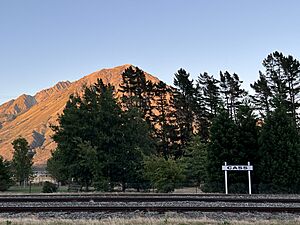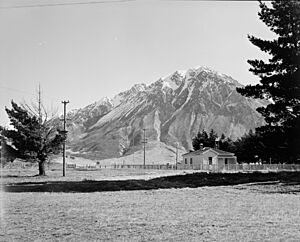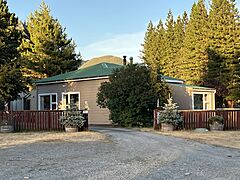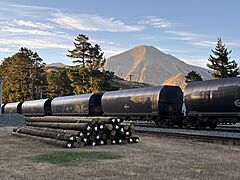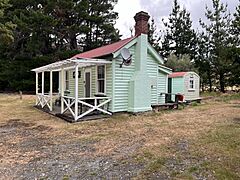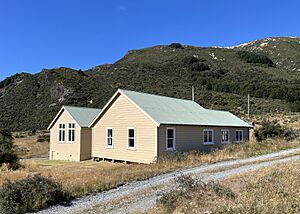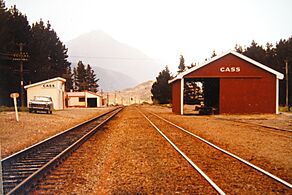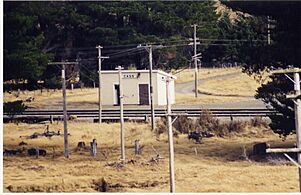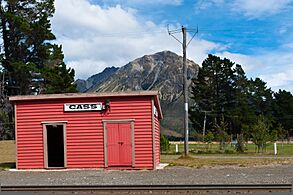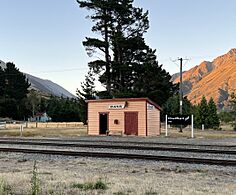Cass, New Zealand facts for kids
Quick facts for kids
Cass
|
|
|---|---|
|
Locality
|
|
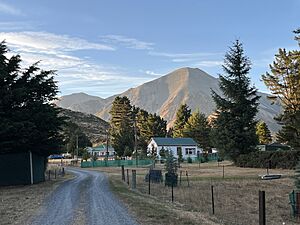
Cass with Baldy Hill to the south
|
|
| Country | New Zealand |
| Region | Canterbury |
| Territorial authority | Selwyn District |
| Elevation | 600 m (2,000 ft) |
| Time zone | UTC+12 (New Zealand Standard Time) |
| • Summer (DST) | UTC+13 (New Zealand Daylight Time) |
| Postcode |
7580
|
| Area code(s) | 03 |
| Local iwi | Ngāi Tahu |
Cass is a very small place in the Canterbury region of New Zealand's South Island. It is located inland, close to Arthur's Pass. Cass is famous for its tiny railway station. This station was painted in 1936 by a well-known artist named Rita Angus. Her painting, also called Cass, was voted New Zealand's favourite artwork in 2006.
Cass is also home to a University of Canterbury field station. This station was set up in 1914 and is used for studying nature. Today, Cass has only one person living there permanently.
Contents
Where is Cass?
Cass is found in the Selwyn District of western Canterbury. It sits in the Cass River basin, which is part of the larger Waimakariri River basin. It is about 22 kilometers (14 miles) from Arthur's Pass. You can reach Cass by driving 105 kilometers (65 miles) from Christchurch along State Highway 73. The Midland Line railway also passes through Cass.
The area around Cass is a flat plain. This plain is surrounded by mountains that are 1,200 to 1,800 meters (3,900–5,900 feet) high. These mountains are part of ranges like the Black Range and Craigieburn Range. East of Cass, you can see Cass Hill and Sugar Loaf. To the west are Mount Misery and Mount Horrible. There are also two smaller hills on the plain called Romulus and Remus.
The landscape of Cass was shaped by glaciers a very long time ago. As the glaciers melted, rivers built up the valley floor. Lakes Sarah and Grasmere nearby were formed by piles of rock left by the ice. Many valleys around Cass were created by erosion after the Poulter Glacier disappeared about 13,000 years ago.
Cass's Past
Long ago, the Ōtira Gorge route was used by Māori people. They traveled between Canterbury and Westland. There are signs that Māori hunted moa and had forest fires in the Cass area about 600 years ago. Travelers would have found eels and birds in the lakes around Cass for food.
After European settlers arrived, they started looking for new places to farm sheep. Joseph Pearson and W. Sidebottom were the first Pākehā (European New Zealanders) to explore the Cass area in 1857. Soon, large farms for Merino sheep were set up. By 1860, farms like Grasmere and Mount White were already running.
Joseph Dawson arrived from Australia in 1860. He farmed at Grasmere Station and built a small cottage. This cottage is now part of the fancy Grasmere Lodge. Cass was named after Thomas Cass. He was the Chief Surveyor of Canterbury from 1851 to 1867.
By 1865, a road and a telegraph line were built through Cass. They went as far as the Bealey River. The Cobb & Co. coach company started a service. Coaches carried passengers and mail twice a week to the Bealey Accommodation House. By 1866, they reached the gold fields in Hokitika. In 1866, many sheep and cattle were moved through the Pass to feed the gold miners. Cora Lynn station in Cass was used to hold animals. Oats were grown there to feed the coach horses.
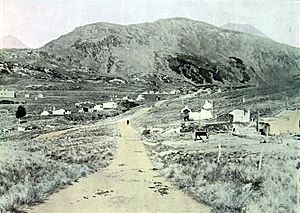
The coach route led to more buildings in Cass. There were stables, a hotel, a police station, and a Road Board office. This office later held the Upper Waimakariri Book Library. In the late 1800s, Cass Flats hosted an annual horse race. After the races, there was a dance at the Road Board office.
In 1873, Canterbury College (now the University of Canterbury) was given a lot of land in the area. They leased this land to farmers. Wool was taken to Christchurch by horse-drawn wagons. Later, steam-powered engines called traction engines were used. This continued until the railway arrived.
The building of the Midland Line railway connected Christchurch to the West Coast. In December 1910, a large construction camp for 800 workers was set up in Cass. At that time, Cass was the end of the railway line. It was also where the coach road started. The town was very busy then. It had three stores, a fabric shop, a blacksmith, a dining room, a butcher, a police station, and a school. In July 1914, the railway station and many people moved to Arthur's Pass. Cass then became a smaller "flag station," meaning trains only stopped if someone signaled them.
Cass was connected by rail to the West Coast when the Otira Tunnel was finished in 1923. Trains used to stop at Cass twice a day. However, since 1987, the only passenger train is the TranzAlpine. This train is for tourists and usually does not stop in Cass.
Cass's Population
As of 2024, Cass has only one permanent resident. His name is Barrie Drummond. He is a railway worker who moved there when he was about 40 years old. He has worked for KiwiRail (New Zealand's railway company) for over 25 years. He helps with switching trains and maintaining the tracks. This makes Cass one of the few places in the world with a population of just one person!
There is one house in Cass that belongs to KiwiRail. It is said to be the last KiwiRail-owned house in New Zealand. There are also several holiday homes in the area.
Barrie Drummond also organizes a yearly event called the "Cass Bash." This is a cricket match held every November. Locals play against people from KiwiRail. About 250 visitors come to Cass for this fun weekend. One of the railway sheds has been turned into a bar and music stage for the event. Barrie has also built a miniature golf course and a bowling green in Cass.
University Field Station
- Further information: Cass Field Station
The University of Canterbury has a special place called a field station at Cass. This station is often used for university students to go on field trips and do research. It was first planned for a different location, but because the railway construction camp was in Cass, the Mountain Biological Station opened there in March 1914.
The first building had a living room and bunk beds, but no lab. In 1929, the building was made bigger. It got a lab, a coal stove, hot water, and a bathroom. Another building was added in 1959.
Students use the field station for trips to learn about nature. Researchers also use it to study things like tussock grass, sheep grazing, entomology (insects), glaciology (glaciers), climate, freshwater ecology (water environments), and plant systematics (how plants are related).
Charles E. Foweraker did the first research project there in 1915. His old photos of the area are very helpful. They show how the plants have changed over the last 100 years. Other important photos of the field station were taken by Ellen Heine. These are kept at the National Museum of New Zealand Te Papa Tongarewa.
Between 1975 and 1977, a new building called the Teaching Flat was built next to the original station. The old station was updated with new teaching spaces and lab equipment. In December 2014, the University of Canterbury celebrated 100 years of teaching and research at the Cass Field Station.
Rita Angus's Famous Painting Cass
- Further information: Cass (painting)
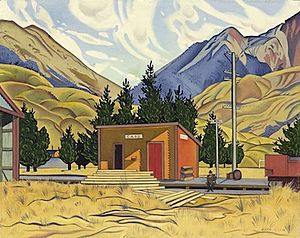
In May 1936, an artist from Christchurch named Rita Angus took a three-hour train ride to Cass. She went with two other painters, Louise Henderson and Julia Scarvell. They stayed for ten days at the Biological Station. They spent their time sketching the beautiful landscape around them. Both Angus and Henderson painted the small railway station.
Rita Angus's painting, called Cass, is very important. It has been called "one of the most important artworks of the 1930s and of New Zealand art history." In 2006, people voted it New Zealand's greatest painting. This happened in a poll on the Frontseat arts TV show.
The railway station in the painting is a simple building. It has two rooms, wooden sides, and a corrugated iron roof. It was built in 1911. When Angus painted it, a larger building and a refreshment room had been removed. However, a goods shed was still there. The station building is still standing today.
In the 1980s, the station was painted white. But in the late 1990s, it was repainted a reddish-brown color. This color is sometimes called "Museum Red." It was possibly done to make it look more like the Angus painting. In the early 2020s, it was painted again, this time tan with red trim. More than 1,000 visitors come to Cass each year to see and take pictures of this famous railway station.


